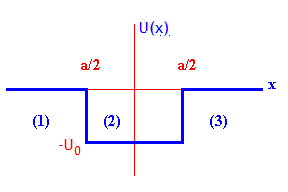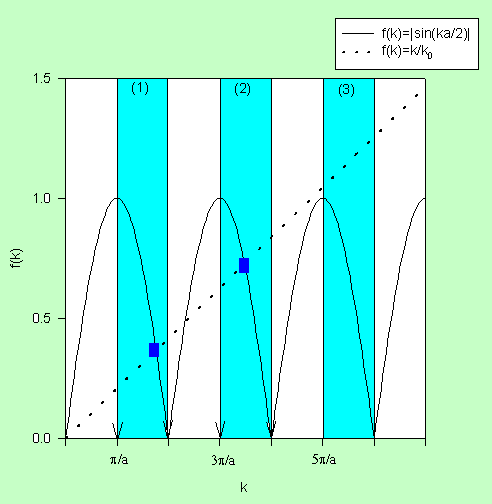
Problem:
Consider the square potential well shown in the figure below.

(a) Find the most general solution Φ(x) of the eigenvalue
equation HΦ(x) = EΦ(x), (E < 0), in regions 1, 2, and 3 and apply boundary
conditions.
(b) Solve the equation that results from part (a) graphically, and find the
conditions under which even and odd solutions exist.
Solution:
- Concepts:
This is a "square potential" problem. We solve HΦ(x)
= EΦ(x) in regions where U(x) is constant and apply boundary conditions.
- Reasoning:
We are given a piecewise constant potential and are asked to find
bound-state solutions.
- Details of the calculation:
Let -U0 < E < 0. The wave function must remain finite at x = ±
∞. We therefore have:
Φ1(x) = B1eiρx, Φ2(x)
= A2eikx
+ A2'e-ikx, Φ3(x) = B3'e-iρx,
with k2 = (2m/ħ2)(E + U0) and ρ2
= (2m/ħ2)(-E).
Φ and ∂Φ/∂x are continuous at x = ± a/2 This implies:
B1e-ρa/2 = A2e-ika/2 + A2'eika/2, B3'e-ρa/2
= A2eika/2 + A2'e-ika/2.
ρB1e-ρa/2 = ikA2e-ika/2 -
ikA2'eika/2, -ρB3'e-ρa/2
= ikA2eika/2 - ikA2'e-ika/2.
Solving for A2 and A2’ in terms of B1
we obtain
A2 = e(-ρ + ik)(a/2)(ρ + ik)/(2ik)B1,
-A2' = e-(ρ + ik)(a/2)(ρ - ik)/(2ik)B1.
Solving for A2 and A2’ in terms of B3’
we obtain
-A2 = e-(ρ + ik)(a/2)(ρ - ik)/(2ik)B3',
A2' = e(-ρ + ik)(a/2)(ρ + ik)/(2ik)B3'.
This yields two equations for B3’ in terms of B1,
-B3' = [(ρ + ik)/(ρ - ik)]eikaB1 and
-B3' = [(ρ - ik)/(ρ + ik)]e-ikaB1,
which can only simultaneously be satisfied if
[(ρ - ik)/(ρ + ik)]2 = e2ika.
There are two possible solutions.
Solution 1:
[(ρ - ik)/(ρ + ik)] = -eika
But we also have
[(ρ - ik)/(ρ + ik)] = [(ρ2 + k2)1/2e-iθ/(ρ2
+ k2)1/2eiθ] = e-i2θ, with cotθ
= ρ/k.
This implies
e-i2θ = -eika, -2θ = ka - π, cotθ = cot(π/2
- ka/2) = tan(ka/2) = ρ/k.
How do you solve an equation like this for k?
We can try a graphical solution.
Define k02 = 2mU0/ħ2
= k2 + ρ2.
Then 1/cos2(ka/2) = 1 + tan2(ka/2) = (k2 +
ρ2)/k2 = k02/k2,
or |cos(ka/2)| = k/k0
for all k for which tan(ka/2) ≥ 0.
Note: We changed from a tangent to a cosine function for easier graphing.

In regions (1), (2), (3,) ... tan(ka/2) ≥ 0. Three solutions exist for the
given k0 in the graph. As we increase k0 more
solutions become possible. For every k0 at least one solution is
possible. There exists at least one bound state. But we have not yet found
the complete set of solutions.
Solution 2:
[(ρ - ik)/(ρ + ik)] = +eika
This
implies e-i2θ = eika, -2θ = ka, cotθ =
cot(-ka/2) = -cot(ka/2) = ρ/k.
Then 1/sin2(ka/2) = 1 + cot2(ka/2) = (k2 +
ρ2)/k2 = k02/k2,
or |sin(ka/2)| = k/k0
for all k for which cot(ka/2) ≤ 0.
We construct a similar graph to get more solutions.

After we have found our solutions for k we can substitute [(ρ - ik)/(ρ
+ ik)] = ±eika back into
the equations giving the relations between the A’s and B’s. We find:
if [(ρ - ik)/(ρ + ik)] = -eika then A2
= A2', B1 = B3', Φ(-x) = Φ(x), the
solutions are even;
if [(ρ - ik)/(ρ + ik)] = +eika then A2 = -A2',
B1 = -B3', Φ(-x) = -Φ(x), the solutions are odd.
For k0 ≤ π/a only one (even) solution exists.
If π/a ≤ k0 ≤ 2π/a the first odd solution becomes possible.
If k0 is very large, then the slope of the straight line is very
small and solutions appear near every k = nπ/a (n = integer). Consequently
En = n2π2ħ2/(2ma2) -
U0.
These are the energy levels of the infinite square well.
Summary
The operator representing the energy of a system is H. The eigenvalues of H
are E. If the potential U(x) is independent of time, then separation of
variables is possible, and we can write ψ(x,t) = Φ(x)Χ(t). If the wave function
is of this form, then Φ(x) = ΦE(x) is an eigenfunction of the
operator H, and the energy of the system is certain.
We find the eigenfunction
of H by solving HΦE(x) = EΦE(x).We can solve this equation in regions of piecewise constant potentials.
- Regions that do not contain a well
- There exists an eigenfunction for every E > Umin. These
eigenfunctions, however, are plane waves and are not square integrable.
They cannot represent a single particle, but can represent a constant
flux of particles. We calculate transmission and reflection
coefficients by comparing fluxes.
(Flux = k|Φ(x)|2.)
- Regions that do contain a well
- There exists an eigenfunction for every E > Erim. These
eigenfunctions are not square integrable.
- For E < Erim eigenfunctions exist only for selected
eigenvalues. We can solve for the bound states in a square-well
potential using a graphical solution.
Confinement leads to energy quantization.




